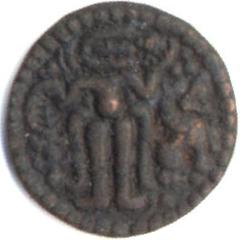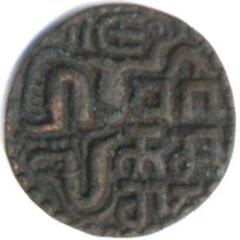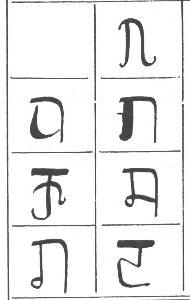| SPECIFICATIONS | |
| Denomination | massa |
| Alloy | Copper |
| Type | Struck |
| Diameter | 20.32 mm |
| Thickness | mm |
| Weight | 4.17 gms |
| Shape | Round |
| Edge | Plain |
| DieAxis | O° |


|

| 
| ||||||||||||||||||||
| Codrington #97 | Mitchiner #853-855 | |||||||||||||||||||||
|
Obverse : Similer to Lankan massa design of standing king. The head consists of an oblong, from the chord of which project three lines; crown or makuta, two arcs and a dot in rear. right elbow more pronounced; in right hand a lamp consisting of a straight line ending in a ball and flanked on eitherside by two dots. In left hand a small ball. Feet turned outward. Two dots, one under each arm, represents the upper part of the dhoti. To right a lion seated and facing right with left foreleg uplifted; each paw has three claws. A rim is a circle of large dots. Reverse : Traditional Lankan massa design of seated king. Head and crown as on obverse. Arm is raised upwards and the hand holds a small ball. On right Nagari legend Sri Pa ra kra ma Ba hu | 
|
Parakramabahu the Sixth was chosen to be king by Sinhala emissaries present in the Ming Court at the time, nominated by Emperor Yongle and effectively installed by Zheng He using the military and naval power at his disposal. Irrespective of what might today be called "foreign interference" in ensuring Parakramabahu the Sixth's consolidation of power, he went on to become Lanka's last "great" king under whose rule the island was politically "unified" which also ensured political stability and a phase of significant cultural revival. Ref
I wonder if the seated lion that appears for the first time on this massa coin of Parakaranabahu Sixth, is in fact, the Chinese Lion.
In 2021 a Fantasy Rs10,000 note circulated on Social Media because of the increased influence of China on Sri Lanka and was reported by FactSeeker.LK
This coin is scarce unlike the six fairly common copper massa coins from the late Polonnaruwa and Dambadeniya era.
Text edited from
* "Short history of Ceylon: H. W. Codrington, Colombo, 1929.
* Ceylon Coins and Currency: H. W. Codrington, Colombo, 1924.
Chapter VI Mediaeval Lanka - The ``Lion'' Type, Page 78
The coin was scanned at 300dpi and displayed at 300dpi. It was obtained in December 1999 from Rajah Wickremesinhe an Author and collector in Colombo, Lanka, who also pointed out my error of adopting the attribution in Mitchiner of this coin to ParakramaBahu III (1302-1310)